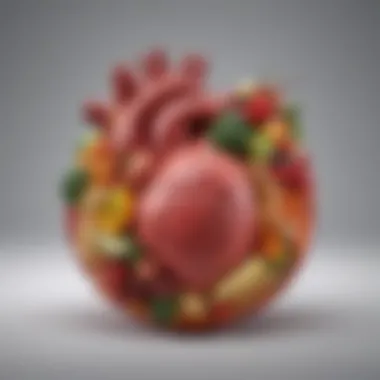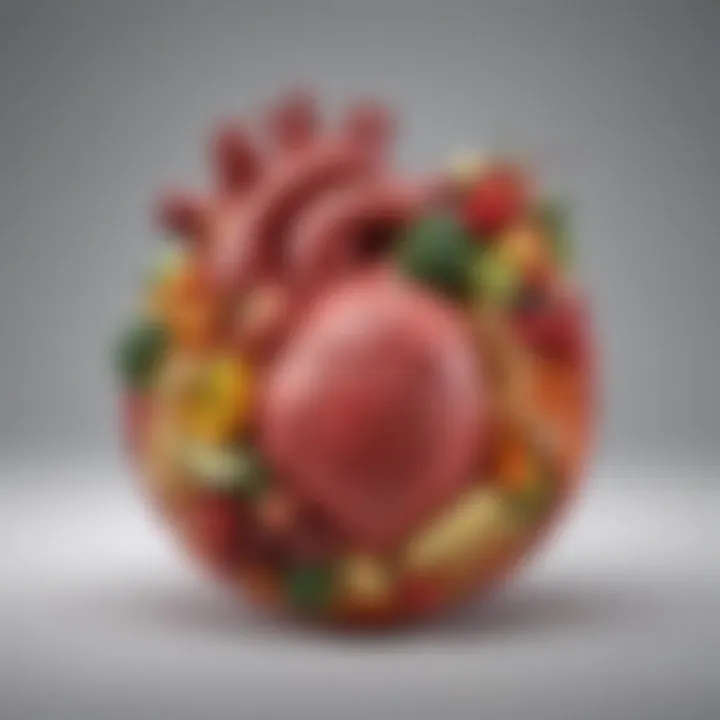Heart Arrhythmia Diet: Key Foods for Heart Health


Intro
When it comes to heart health, many often overlook the connection between diet and heart arrhythmias. Heart arrhythmias can strike like lightning, bringing a wave of concern that often leads individuals to seek answers. In this guide, we’ll break down the significance of dietary choices and their relationship with heart rhythm irregularities. It’s not just about what you eat; it's about how those foods interact with your body.
As we delve into the components of a heart-friendly diet, it's crucial to understand the interplay between specific nutrients and the overall cardiovascular system. Nutritional knowledge isn’t just academic; it’s a lifeline for those grappling with arrhythmias. This guide aims to illuminate the path toward dietary adjustments that could make a real difference in managing heart conditions.
Summary of Objectives
This article aims to shed light on how dietary factors play a role in managing heart arrhythmias. By focusing on different food categories, we delve into how certain nutrients can either support or undermine heart health. Ultimately, the goal is to empower individuals with knowledge that enables them to make informed decisions about their diet.
Importance of the Research
Understanding the relationship between diet and heart arrhythmias is not just of interest to health professionals; it holds paramount importance for anyone affected by these conditions. Nutritional interventions could significantly enhance the quality of life and reduce the risks associated with arrhythmias. The information compiled here fosters a deeper comprehension of how seemingly everyday food choices can impact heart health.
Results and Discussion
Presentation of Findings
Through research and analysis, we found that certain food types have beneficial properties for heart health. Foods rich in omega-3 fatty acids, such as salmon and walnuts, can be particularly advantageous. Similarly, fruits and vegetables high in potassium—like bananas and spinach—have been shown to support normal heart function.
However, just as some foods can help, others can hinder. High levels of sodium, sugar, and saturated fats can aggravate the symptoms of arrhythmias. The findings underscore the importance of balance and mindfulness in food selection.
"Optimal nutrition isn't a one-size-fits-all approach; it’s a personal journey perfectly tailored to individual health needs."
Implications of Results
The results have far-reaching implications for dietary guidelines tailored for those at risk of or currently experiencing arrhythmias. Realizing that adopting a heart-healthy diet can drastically alter one’s health trajectory cannot be overstated. This approach isn’t solely about restriction; it’s about embracing a variety of nutrient-rich foods that foster heart health while providing a satisfying culinary experience.
Understanding Heart Arrhythmia
When discussing heart health, it’s vital to grasp the concept of heart arrhythmia. This issue relates not just to the rhythm of the heart but also to how these irregularities can influence a person’s overall well-being. An understanding of heart arrhythmias can be particularly beneficial for individuals who are looking to modify their diets and lifestyle to manage their heart conditions better. Not only will this knowledge help in recognizing symptoms but will also aid in making informed dietary choices that can positively impact heart function.
The complexity of heart rhythms encompasses various types, each carrying different implications for health. Knowing what arrhythmia is and how it operates helps individuals appreciate the significance of lifestyle management.
Moreover, awareness frequently leads to early detection, which can be crucial. The faster one understands potential irregularities, the sooner they can seek medical guidance. This understanding can also foster a proactive approach toward choosing heart-healthy foods, which can mitigate risks tied to these rhythm disorders.
"The heart’s rhythm is like a song; when it's in harmony, life flourishes. When it falters, every beat counts."
Definition of Heart Arrhythmia
Heart arrhythmia refers to any disruption in the regular rhythm of the heart. The heart normally beats in a steady, organized rhythm, but when there are encounters with electrical signals malfunctioning within the heart, it can lead to various kinds of arrhythmias. These conditions could manifest as the heart beating too fast, too slow, or in an irregular manner.
Several terms may surface when discussing arrhythmias, such as atrial fibrillation and ventricular tachycardia, which further detail the condition based on its causes and effects. Essentially, arrhythmias can affect blood flow, potentially causing serious health risks if not managed properly.
Types of Heart Arrhythmias
Arrhythmias come in different forms, each with its own characteristics. Understanding these types can assist individuals in identifying their condition better. Some common types include:
- Atrial Fibrillation: This involves rapid, irregular beating of the heart's upper chambers. It's often silent but can lead to blood clots and strokes.
- Bradycardia: A slower-than-normal heart rate, which can cause fatigue and confusion.
- Tachycardia: Conversely, this is an abnormally fast heart rate that can appear from stress or other conditions.
- Ventricular Fibrillation: Very dangerous; the heart’s lower chambers quiver instead of pumping effectively, leading to a lack of blood flow.
Recognizing these types can help individuals grasp their risk factors and symptoms.
Symptoms and Diagnosis
The symptoms of heart arrhythmias can sometimes go unnoticed. However, some common indications may include:
- Palpitations or a sensation of your heart racing
- Dizziness or lightheadedness
- Shortness of breath
- Fatigue
- Chest pain
If symptoms arise, it's crucial to consult a healthcare professional. They might use various diagnostic tools, such as an electrocardiogram, to determine the specific type of arrhythmia.
Recognizing and diagnosing these symptoms early can be life-saving, influencing the choices made regarding meal planning and lifestyle adjustments.
The Connection Between Diet and Heart Health
Understanding how diet intertwines with heart health is crucial, especially for those grappling with heart arrhythmias. The foods we consume don’t just fuel our bodies—they play a significant role in regulating heart rhythm and function. When it comes to cardiac well-being, there’s no one-size-fits-all. Instead, a variety of factors, including individual metabolism and lifestyle choices, come into play.


Embracing a heart-healthy diet is not merely a recommendation; it’s an essential strategy for managing arrhythmias and overall heart function. Diet impacts our metabolic health, influencing the risk of developing other conditions like hypertension and obesity, which can escalate the severity of arrhythmias. Thus, carefully selecting what’s on our plates can lead to profound changes in heart health.
The relationship between specific nutrients and heart functionality reveals the significance of the connection we’ll explore. Prioritizing foods that reduce inflammation, stabilize blood pressure, and maintain a healthy weight can be the linchpin of preventing further arrhythmias. Adopting a well-rounded dietary approach encompasses not just what one eats, but how it’s prepared and consumed.
Nutritional Components Influencing Heart Health
Diving deeper into the nutritional components that exert benefits on heart health reveals specific elements that prove pivotal in preventing arrhythmias. Here are some key players:
- Omega-3 Fatty Acids: Found predominantly in fatty fish like salmon and mackerel, these fats can help reduce inflammation and stabilize heart rhythms. They may lower the risk of sudden cardiac death.
- Potassium: Foods like bananas, oranges, and sweet potatoes are rich in potassium. This mineral is essential for maintaining normal heart function, as it helps regulate heartbeats and manages blood pressure levels.
- Magnesium: Nuts, seeds, and whole grains provide magnesium. It plays a big role in hundreds of biochemical reactions in the body, including muscle function, nerve signaling, and heart rhythm stabilization.
Each nutrient acts uniquely yet synergistically, forming a mosaic of benefits that fortify heart health and assist in managing arrhythmias.
Dietary Patterns Linked to Heart Health
Shifting from individual nutrients to dietary patterns yields insights into broader eating habits that can influence heart health. Various diets have garnered attention for their heart health benefits:
- Mediterranean Diet: Known for its emphasis on whole foods, rich in fruits, vegetables, nuts, and healthy fats, this diet has shown promise in reducing cardiovascular diseases. Regular consumption of olive oil offers a burst of antioxidants and anti-inflammatory properties.
- DASH Diet: Originally crafted for hypertension, the Dietary Approaches to Stop Hypertension (DASH) promotes high fiber intake and limits saturated fat. This can benefit heart health significantly, thus potentially mitigating arrhythmia risks.
- Plant-Based Diets: Emphasizing vegetables, whole grains, and legumes offers a plethora of nutrients that support heart rhythm balance. The fiber-rich nature of plant-based diets may also promote a healthier weight, which is crucial for heart health.
By focusing on these dietary patterns, individuals can create a sustainable approach to eating that aligns well with their heart health needs. In addition, awareness of serving sizes and meal timing, along with an understanding of the psychological aspects surrounding food choices, can enhance the effectiveness of these dietary approaches.
"A healthy diet is not about restrictive eating; it’s about nutritional empowerment to fortify heart health."
By forming connections between diet and heart health, individuals are much better equipped to make informed choices that could lead to healthier hearts and potentially fewer episodes of arrhythmias.
Essential Dietary Components for Arrhythmia Management
Diet plays an integral role in managing heart arrhythmias. The heart is a surprisingly demanding organ, and it requires the right nutrients to function correctly. When someone's diet lacks essential components, it can lead to increased risk for various heart issues. It's not just about eating enough; it's about eating the right things that provide the body what it needs to help maintain a steady heartbeat and reduce arrhythmia occurrences.
Omega-3 Fatty Acids
Omega-3 fatty acids are known for their heart-protective properties. Found in foods like fish, walnuts, and flaxseeds, these compounds work wonders when it comes to heart health. They've been shown to help reduce inflammation and even curb irregular heartbeats. The American Heart Association recommends eating fish—specifically fatty varieties like salmon or mackerel—at least twice a week.
Moreover, omega-3s influence the fluidity of cell membranes, thus potentially stabilizing electrical activity in cardiac tissues. Incorporating a hearty serving of these fatty acids into one's diet can also help manage cholesterol levels and blood pressure. However, individuals should take note; it's best to obtain omega-3s through food sources rather than supplements unless advised by a healthcare professional. The body absorbs these nutrients better when they come from whole foods.
Potassium-Rich Foods
Potassium is another critical player in maintaining heart rhythm. This mineral helps muscles—including the heart—contract and relax efficiently. Bananas may immediately spring to mind, but a balanced diet infused with a variety of potassium-rich foods can provide even better results. Incorporate things like sweet potatoes, avocados, and beans into your meals.
Observing an adequate intake of potassium can combat the effects of excessive sodium as well, further promoting heart health. High sodium levels can lead to high blood pressure, which in turn increases arrhythmia risks. Eating potassium-rich foods can help counterbalance these effects, contributing to a more stable cardiovascular environment.
Magnesium and Its Sources
Magnesium is often an overlooked nutrient, but it deserves a spotlight when discussing arrhythmia management. This mineral plays a role in more than 300 enzymatic reactions within the body, making it vital for heart health. Foods that are high in magnesium include leafy greens, nuts, seeds, and whole grains.
A magnesium deficiency can lead to increased heart rhythm abnormalities. By ensuring that your diet includes sources rich in magnesium, you can aid in maintaining normal rhythms. It’s one of those cases where you can’t see the full picture without every piece.
Besides the direct benefits, magnesium may also have a calming effect on the nervous system, which can contribute to lowering stress levels—an important factor in managing heart arrhythmias.
It's worth noting that drastic dietary changes should always be discussed with a healthcare professional.
In summary, essential dietary components like omega-3 fatty acids, potassium-rich foods, and magnesium can play a key role in managing arrhythmias. Learning to incorporate these foods into one’s diet can significantly impact heart health, ultimately leading to a better quality of life.
Foods to Incorporate into an Arrhythmia-Friendly Diet
Diving into an arrhythmia-friendly diet necessitates a closer look at what one should be eating. Food choices play a pivotal role in supporting heart health and regulating the rhythms of the heart. Incorporating certain foods can provide beneficial nutrients and help manage heart conditions. This section will highlight some key food categories that can contribute positively to individuals experiencing heart arrhythmias.
Leafy Green Vegetables
When it comes to heart-healthy choices, leafy greens stand out like a lighthouse in the fog. Vegetables like spinach, kale, and Swiss chard are not just good-looking on your plate; they pack a punch in terms of nutrition. These greens are rich in vitamins A, C, K, and a whole host of minerals like potassium and magnesium.
Potassium is quite important for heart function. It can help regulate blood pressure, which is crucial for preventing arrhythmias. Magnesium works hand in hand, playing a role in nerve function and muscle contraction, including the heart muscle. Therefore, sprinkling these leafy delights into your meals can serve as a proactive approach to harmony in your heartbeat.
Moreover, leafy greens are loaded with antioxidants, helping to combat oxidative stress and inflammation. It’s like sending in reinforcements to support heart health. A simple green salad or adding greens to a smoothie every day can be a step in the right direction.
Berries and Their Benefits
Berries, the tiny gems of the fruit world, shouldn’t be overlooked. Strawberries, blueberries, and blackberries are all rich in flavonoids, antioxidants, and fiber. Flavonoids especially play a significant role in maintaining heart health.


Research suggests that consuming berries can improve blood vessel function and lower blood pressure, creating an environment conducive for a stable heart rhythm. These succulent fruits can satisfy your sweet tooth while offering numerous health benefits.
A report from the American Heart Association indicates that eating berries on a regular basis can lessen heart disease risk — what better reason to indulge in a bowl of them? They can be added to breakfast cereals or eaten as a snack, making them versatile and easy to integrate into daily routines.
Whole Grains and Heart Health
Whole grains are the unsung heroes when it comes to heart nourishment. Unlike their refined counterparts, grains such as oats, quinoa, brown rice, and farro are rich in fiber, which supports healthy digestion and stabilizes blood sugar levels. Fiber plays a critical role in reducing cholesterol levels, hence lowering the risk of heart disease.
Including whole grains in your diet can also lead to better blood pressure regulation. In fact, studies show that people consuming more whole grains tend to have a lower risk of coronary heart disease. It’s almost like a protective barrier that whole grains offer to the heart.
Whether it’s a hearty bowl of oatmeal in the morning or whole-grain toast with avocado, there are countless ways to weave these grains into your meals. Not only do they satisfy hunger efficiently, but they also provide vital nutrients that contribute to overall cardiovascular health.
Incorporating a variety of these food categories can significantly impact your heart health, offering nutrient density while helping manage arrhythmias. A diverse diet that supports the heart’s needs is a surefire way to facilitate wellness.
Foods to Avoid for Better Heart Health
When it comes to managing heart arrhythmias, the food you consume plays a vital role. Just as certain foods can aid in maintaining a healthy heart rhythm, others can throw a wrench in your efforts and exacerbate conditions. Avoiding specific items can help streamline your heart health journey and potentially lessen the frequency and severity of arrhythmias. This section examines key dietary elements to avoid for better heart health, delving into processed foods, sodium intake, and the effects of caffeine and alcohol.
Processed Foods and Sugars
Processed foods are often laden with preservatives, stabilizers, and added sugars. These items typically have high glycemic indexes, leading to rapid spikes in blood glucose levels, which can place additional strain on your heart. They contribute to inflammation and can disrupt heart rhythms. Foods like fast meals, pre-packaged snacks, and sweetened beverages do not just lack nutritional value; they can also pave the way for long-term health issues including hypertension and obesity.
- Key considerations:
- Read labels diligently.
- Seek out whole food alternatives.
Moreover, sugars, particularly high-fructose corn syrup found in many snacks and soft drinks, can lead to insulin resistance, a condition shown to increase the risk of heart arrhythmias. Aim to limit your intake of sugar-sweetened beverages and processed snacks.
"Not all sugars are created equal. Watch out for hidden sugars in places you may not expect, like sauces and salad dressings."
Excessive Sodium Intake
Sodium, while essential in small amounts, can be detrimental when consumed in excess. High sodium intake has been linked with increased blood pressure, which may influence the heart’s electrical signals, thereby leading to arrhythmias. Many processed foods contain high levels of sodium, which might not be apparent at first glance.
- Helpful tips to reduce sodium consumption:
- Opt for fresh or frozen vegetables instead of canned ones.
- Use herbs and spices to flavor your food rather than salt.
The American Heart Association recommends limiting sodium intake to less than 2,300mg per day. For individuals with arrhythmias or high blood pressure, a lower sodium intake, around 1,500mg per day, might be more appropriate. Staying vigilant about sodium content in your diet is paramount for maintaining heart health.
Caffeine and Alcohol Consumption
While enjoying a cup of coffee or a glass of wine might seem harmless, it's worth considering their impact on your heart. Caffeine can stimulate the heart and potentially trigger arrhythmias in sensitive individuals. The exact mechanism appears varied among individuals, leading some to experience palpitations or irregular heartbeats after caffeine consumption, while others may show no adverse effects. Moderation is critical here; keeping caffeine intake low may improve your heart's rhythm.
On the other hand, alcohol consumption, particularly in larger amounts, has been shown to have a complex relationship with heart health. While moderate drinking has been associated with some health benefits, excessive alcohol can lead to heart muscle damage or contribute to high blood pressure, again complicating heart arrhythmias.
- Guidelines for alcohol consumption include:
- Limit alcohol to no more than one drink per day for women, and two for men.
- Be mindful of mixed drinks which often have high sugar content.
In summary, avoiding processed foods, keeping sodium intake in check, and moderating caffeine and alcohol consumption can significantly impact heart health. Through mindful dietary choices, individuals can shape their heart's rhythm positively, paving the way for enhanced well-being.
The Role of Hydration in Heart Health
Proper hydration plays an essential role in managing heart arrhythmias. The heart is a muscle, and like any muscle, it needs an optimal balance of fluids to perform efficiently. Dehydration can lead to an imbalance in electrolytes, which are crucial for maintaining normal heart rhythms. Furthermore, proper fluid intake aids in maintaining overall cardiovascular function, ensuring that blood, nutrients, and oxygen can flow to vital organs without a hitch.
Understanding Fluid Balance
Fluid balance is a concept that revolves around the equilibrium between the intake and output of fluids in the body. It's not just about drinking water; it's about maintaining the right amount of fluids to keep everything running smoothly. When we consume food and beverages, they are absorbed into our bloodstream, which helps maintain blood volume. If we lose too much fluid through sweating, urination, or vomiting, the heart has to work harder to pump a smaller volume of blood. This strain can trigger arrhythmias, particularly in individuals already vulnerable to heart rhythm disorders.
Here are key points about fluid balance:
- Electrolyte Levels: When hydrated, electrolytes like sodium and potassium help in electrical signaling for heartbeats. Low electrolyte levels can lead to complications.
- Blood Volume Regulation: Adequate fluids ensure optimal blood volume, thus aiding in efficient circulation.
- Temperature Regulation: Fluid helps cool down the body, preventing conditions like heat exhaustion that can influence heart performance.
Hydration Recommendations
Considering the crucial role hydration plays, it's vital to have a strategy for adequate fluid intake. Here are some effective recommendations:


- Daily Fluid Intake: Aim for at least 8-10 cups of water a day. However, individual needs may vary.
- Monitor Urine Color: Light yellow urine is a good indicator of proper hydration. Darker shades may suggest dehydration.
- Balance Electrolytes: Incorporate foods high in electrolytes, such as bananas, avocados, and spinach. Sometimes, drinking electrolyte-rich sports drinks can be beneficial, especially after exercise.
- Timing Matters: Drink water regularly throughout the day rather than chugging a large amount at once. This helps in maintaining a stable hydration level.
- Listen to Your Body: Thirst is the body’s reminder to hydrate. If feeling thirsty, don’t ignore it.
Bottom line: Staying hydrated is more than just drinking enough water. It's about understanding your body’s needs to prevent undue stress on your heart. Every tiny decision you make about fluid consumption can play a part in managing your heart health effectively.
Lifestyle Modifications Beyond Diet
When it comes to managing heart arrhythmia, it's essential to understand that what we eat isn’t the only game in town. Lifestyle modifications play a critical role in the overall management and health of individuals facing this condition. While adopting the right dietary practices lays a solid foundation, incorporating various lifestyle adjustments adds another layer of protection against potential arrhythmia triggers.
Physical Activity and Heart Rhythm
Maintaining a consistent exercise routine emerges as a cornerstone for a healthy heart. Engaging in physical activity has multifaceted benefits that go beyond mere calorie burning. Regular exercise fosters cardiovascular strength, enhances blood circulation, and potentially stabilizes heart rhythm.
It is not about overexertion or lifting weights unless advised by health professionals. Instead, emphasizing low-impact activities like walking, cycling, or yoga can yield substantial benefits without pushing the heart to its limits. Studies suggest that even moderate activity, such as 150 minutes of walking each week, can lower the risk of arrhythmias.
Maintaining an active lifestyle also helps manage body weight. In turn, this can minimize the strain on the heart. Individuals should tailor their routines to balance aerobic, strength, and flexibility training. This multifocal approach not only aids in maintaining heart rhythm but also contributes to overall wellness.
"Movement is medicine" – it's not just a catchy phrase; it's a reminder of the body's design for activity.
Stress Management Techniques
Stress can be insidious, creeping into daily life and wreaking havoc on heart health. High levels of stress frequently contribute to increased heart rates, which can exacerbate arrhythmic conditions. Consequently, developing effective stress management techniques becomes paramount for individuals at risk.
Here are some techniques worth considering:
- Mindfulness and Meditation: Engaging in mindfulness practices can help downgrade heart rates and promote relaxation.
- Deep Breathing Exercises: Focused breathing not only calms the mind but can also directly impact heart rate, making it a handy tool during stressful moments.
- Limit Stimulants: Caffeinated beverages can ramp up anxiety levels. Reducing or avoiding them could aid in maintaining a calm heart rhythm.
- Adequate Sleep: Prioritizing restorative sleep lays the groundwork for effective stress management.
Combining these methods can foster a resilient mindset. When stress isn’t managed effectively, it can spiral, leading to poor dietary choices and inactivity. Deliberate practice of stress-relieving techniques not only serves emotional well-being but also strengthens heart health.
In summary, taking a holistic view of lifestyle modifications – beyond the plate – creates a robust strategy for managing heart arrhythmia. The interplay between physical activity and stress management equips individuals to tackle their condition with more confidence.
Consulting Healthcare Professionals
Navigating the complexities of heart arrhythmias can be daunting. Therefore, consulting healthcare professionals is a pivotal step if one wants to manage this condition effectively. Doctors, cardiologists, and registered dietitians can provide tailored advice. This personalized approach is crucial because every individual’s health is unique, and what works for one might not work for another.
Importance of Medical Guidance
Engaging with a medical professional offers various benefits. Initially, they can conduct thorough assessments and necessary tests, determining the specifics of your heart arrhythmia. This step is vital for establishing a correct treatment plan. Furthermore, they can help in identifying potential triggers such as specific foods or stressors.
Guidance from a medical expert enables a well-rounded understanding of the dietary changes one needs. Consider the following points when seeking medical advice:
- Individualized Care: General dietary recommendations may not cater to personal health nuances. A healthcare professional develops a plan that acknowledges any underlying conditions.
- Safety Concerns: Certain foods or supplements may conflict with medications or exacerbate health issues. Professional insight ensures safety.
- Monitoring Progress: Regular check-ins with a healthcare provider provide a basis for monitoring improvements or the need for adjustments in the dietary plan.
"It's essential not just to look at what you eat, but to also understand how it interacts with your body’s chemistry."
Working with a Registered Dietitian
Registered Dietitians (RDs) play a pivotal role in managing diets for those with heart arrhythmias. These specialists possess a deep understanding of nutrition and can translate complex information into actionable dietary changes.
When collaborating with an RD, here’s what one may expect:
- In-Depth Nutritional Knowledge: They can identify which foods contribute positively to heart health and which ones should be avoided. This specificity may include suggestions for color-rich fruits, leafy greens, and whole grains.
- Meal Planning Assistance: An RD can assist in crafting a comprehensive meal plan that aligns with personal taste and health goals. This plan will strategically incorporate beneficial foods while limiting those detrimental to heart health.
- Support and Motivation: Changing one’s diet can be challenging. A registered dietitian can offer support and help maintain motivation, especially during tough times.
- Long-Term Strategies: They don’t just focus on short-term change. Their guidance is aimed at fostering long-term health improvements. Their role is integral to building sustainable eating habits.
Involving healthcare professionals, particularly in nutrition, can bridge the gap between understanding dietary needs and practical application. This expertise leads to a more informed, confident approach to managing heart arrhythmias.
The Ends and Recommendations
In the realm of heart arrhythmia, understanding the significant role of diet cannot be overstated. The Conclusions and Recommendations section serves as a vital recap, bringing together the threads of information woven throughout this article. It highlights not only the dietary adjustments that can influence heart rhythm but also emphasizes the importance of viewing these changes as part of a broader lifestyle strategy.
Summarizing Key Dietary Guidelines
To better navigate the dietary landscape surrounding heart arrhythmia, consider these essential guidelines:
- Omega-3 Fatty Acids: Incorporate sources like salmon, flaxseeds, and walnuts, which are known to promote cardiovascular health.
- Hydration: Maintain an adequate fluid intake, as dehydration can potentially trigger arrhythmias.
- Potassium and Magnesium: Foods such as bananas, sweet potatoes, and spinach are crucial in managing electrolyte balance, which is essential for heart function.
- Limit Processed Foods: Reducing intake of high-sodium and sugary foods can significantly improve heart health.
- Mindful Drinking: Being cautious with caffeine and alcohol can help minimize irregular heartbeats, supporting overall wellness.
These guidelines are not only practical but are built on the foundation of scientific research that points to their efficacy in managing heart health.
“Dietary choices are powerful tools in steering the course of heart health,” — an essential takeaway from numerous studies, reflecting the influence of nutrition on physical well-being.
Future Directions in Heart Arrhythmia Research
As we look towards what lies ahead in heart arrhythmia research, there is a palpable sense of optimism. Here are some emerging trends in research and potential areas of exploration:
- Personalized Nutrition: Tailoring diets to individual genetic profiles could uncover unique approaches to managing heart rhythm disorders.
- Microbiome Studies: Further investigation into the gut-heart connection may reveal how gut health impacts arrhythmia and overall heart health.
- Longitudinal Studies: Ongoing research tracking dietary habits over time can yield valuable insights into how sustained dietary changes affect arrhythmia prevalence and severity.
- Technological Advances: The use of wearable health technology to monitor heart metrics in real-time can lead to more responsive dietary and lifestyle interventions.
By delving into these questions, researchers may chart new pathways for effective management of heart arrhythmias through diet, further contributing to improved outcomes for affected individuals.
In summary, addressing heart arrhythmia requires a multifaceted approach, with diet being a cornerstone of effective management. By integrating dietary guidelines with ongoing research insights, we step closer to a future where heart health is within everyone's reach.















